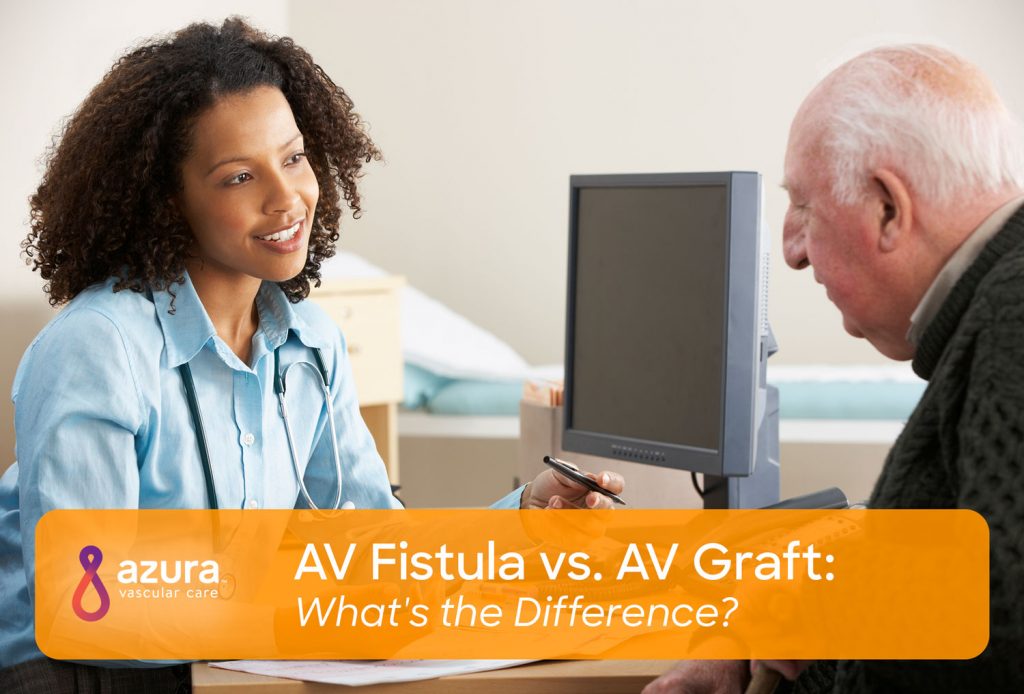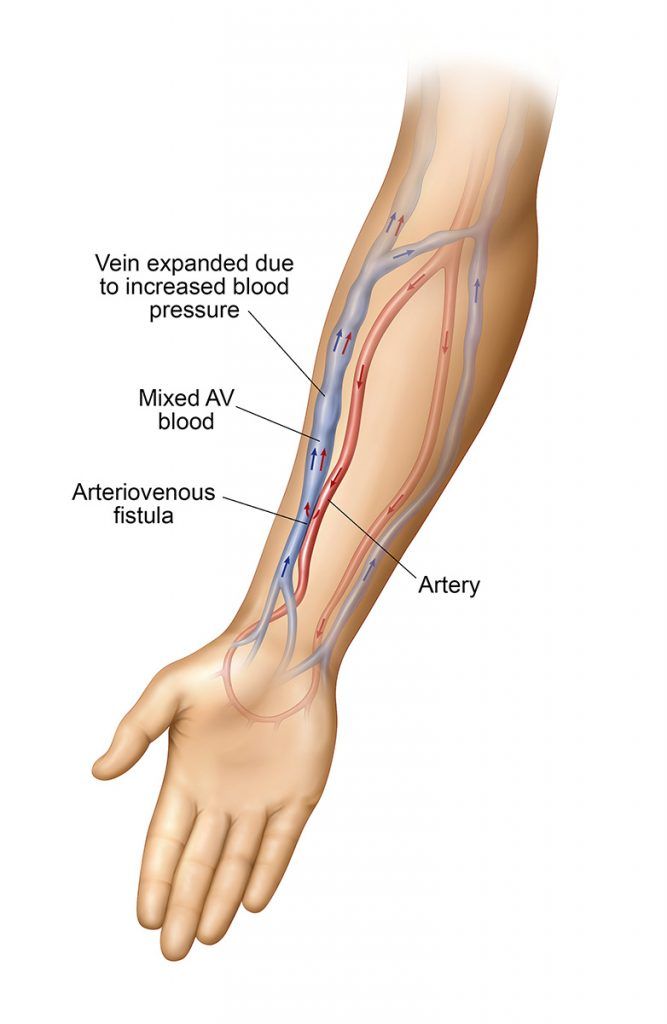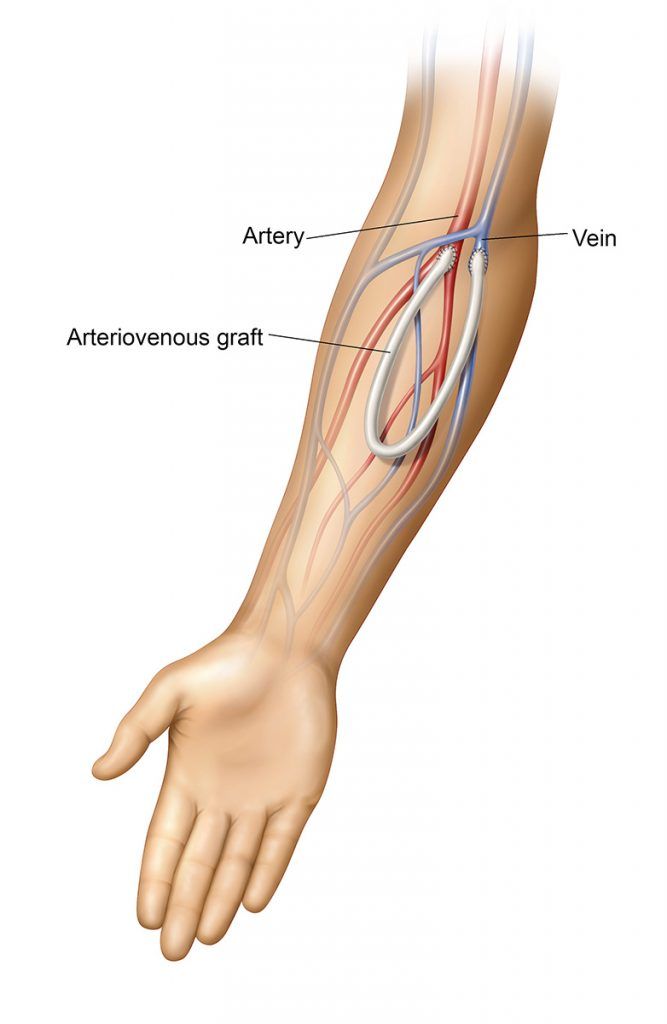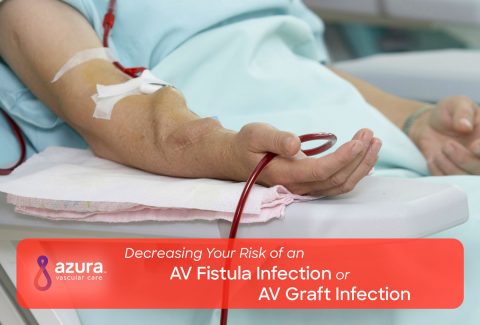
If you or a loved one is preparing to start hemodialysis, you most likely have questions. Among them may be what options you have for a vascular access. In many cases, a doctor will make a recommendation, but you may still prefer to educate yourself about existing choices. Read on to compare the two most common access types for hemodialysis: AV fistulas vs. AV grafts.
Understanding Dialysis
Hemodialysis is a lifesaving medical treatment for patients with kidney failure. If your kidneys are not functioning adequately, they may not be able to successfully filter waste and remove excess fluids from your blood. Dialysis is a process that filters and cleans the blood, replacing the function of healthy kidneys. (i)
To receive hemodialysis treatments, you must have a vascular access, an accessible entry site into your bloodstream, which allows blood to flow to and from your body during dialysis. Options for long-term accesses include AV fistulas and AV grafts. (ii)
What Are AV Fistulas and Grafts?
“AV” is short for arteriovenous, referring to the connection created between an artery and a vein. Your arteries carry oxygen-rich blood from your heart and lungs to the rest of your body. Your veins then carry oxygen-depleted blood back to the heart and lungs. (ii)
AV fistulas are usually created in the forearm but may sometimes be placed in the upper arm or leg. If possible it’s best to have the fistula placed in your non-dominant arm. The fistula is created during a surgical procedure joining one of your arteries with a vein. (ii)
Like a fistula, an AV graft is typically placed in the arm. But unlike a fistula, an AV graft is a synthetic tube used to surgically connect the artery and vein. This tube functions as a vein, carrying blood through the access. (ii)
The goal with both fistula and graft procedures is to direct blood from an artery into a vein, increasing blood pressure and blood flow through the vein. (ii) After the link is created, the vein will become enlarged because more blood is now flowing through the vein. The increased blood flow allows your blood to travel through the dialysis machine at a flow rate necessary for filtering, cleaning, and removing excess fluid from the blood.
Comparing AV Fistula vs. AV Graft
AV Fistula Advantages
 An AV fistula is often considered the “gold standard” of dialysis accesses. (ii) Fistulas have significant advantages over other forms of access. A fistula is:
An AV fistula is often considered the “gold standard” of dialysis accesses. (ii) Fistulas have significant advantages over other forms of access. A fistula is:
- Less likely to become infected.
- Less likely to clot.
- Longer lasting.
When a fistula is functioning properly, it will provide a good blood flow rate from your body to the dialysis machine, assuring the effectiveness of the dialysis treatment. A fistula is the most natural access since it is formed from your own native blood vessels, rather than synthetic materials. (iii) Functioning fistulas typically require less maintenance and can be less expensive than other access options. (iv)
AV Fistula Disadvantages
Fistulas do have a few drawbacks. Although a fistula can be created during a simple outpatient procedure, it takes time for the fistula to develop, or mature. Fistulas often take three to four months to fully mature. Until that point, they may not provide enough blood flow to support dialysis. (v)
Patients with end-stage renal disease (ESRD) may not be able to wait that long to begin treatment. If you need to start dialysis right away, you may need to have some type of temporary hemodialysis access placed until your fistula is ready. (v)
Some patients may also be unable to have a fistula created if their veins are small or weak. Fistulas also sometimes fail to develop properly. Several studies have suggested that up to a third of fistulas may fail to mature. (vi) However, fistula failure rates vary depending on many factors.
AV Graft Advantages
 If a fistula is not an option for you the next best type of dialysis access is an AV graft. Like fistulas, grafts also have advantages and disadvantages. Grafts may be:
If a fistula is not an option for you the next best type of dialysis access is an AV graft. Like fistulas, grafts also have advantages and disadvantages. Grafts may be:
- Suitable for patients with small or weak veins.
- Ready for use within two weeks. Some early cannulation grafts may support use within 72 hours. (vii)
- If necessary, a graft may be replaced with a fistula if veins get stronger or bigger after being on dialysis. (iii)
- Can be performed as an outpatient procedure.
AV Graft Disadvantages
Grafts have significant disadvantages. Grafts are made from a synthetic material and are more prone to infection and clotting. Blood clots in a graft may lead to an aneurysm, a potentially serious complication. Blood clots can also block the flow of blood through the graft. The graft will then need to be declotted, which may result in missing your next scheduled dialysis treatment. (ii)
Which Option Is Right for Me?
Every patient has unique medical needs. Different methods of dialysis access may be better for some, but most vascular doctors consider fistulas to be the preferred option. (ii)
Fistulas May Cost Less. Several studies have indicated that fistulas can be the most cost-effective option. (iii) While overall cost may depend on the length of treatment, fistulas are durable. They’re also less prone to infection or other expensive complications.
Fistulas May Be More Effective. Fistulas are less likely to clot and don’t need as much maintenance as grafts. Fistulas often provide a better blood flow rate to the hemodialysis system, which can make the dialysis process more effective. (ii)
Fistulas Last Longer. If a graft is well cared for, it may last for several years, but a healthy AV fistula is still more durable. (ii) Because it requires less maintenance, fistulas usually present a better long-term option.
Choosing an access option is a big decision. It’s always best to talk with your doctor to better understand which option will meet your needs. You can prepare for this conversation by downloading our Understanding Your Hemodialysis Access guide. This guide provides detailed information about AV fistulas vs. AV grafts, frequently asked questions, and tips on how to care for your access.
Sources:
(i) Fresenius Kidney Care. What is dialysis? Retrieved October 8, 2018, from https://www.freseniuskidneycare.com/ckd-treatment/what-is-dialysis
(ii) U.S. Department of Health and Human Services. (2018, January 01). Hemodialysis. Retrieved September 24, 2018, from https://www.niddk.nih.gov/health-information/kidney-disease/kidney-failure/hemodialysis
(iii) Fresenius Kidney Care. Choosing your best dialysis access. Retrieved October 8, 2018, from https://www.freseniuskidneycare.com/ckd-treatment/types-of-dialysis-access
(iv) Leermakers, J., Bode, A., Vaidya, A., Sande, F. V., Evers, S., & Tordoir, J. (2013). Cost-effectiveness of vascular access for haemodialysis: Arteriovenous fistulas versus arteriovenous grafts. European Journal of Vascular and Endovascular Surgery, 45(1), 84-92. doi:10.1016/j.ejvs.2012.10.012
(v) Texas Heart Institute. Vascular access for hemodialysis. Retrieved October 11, 2018, from https://www.texasheart.org/heart-health/heart-information-center/topics/vascular-access-for-hemodialysis/
(vi) Siddiqui, M. A., Ashraff, S., & Carline, T. (2017). Maturation of arteriovenous fistula: Analysis of key factors. Kidney Research and Clinical Practice, 36(4), 318-328. doi:10.23876/j.krcp.2017.36.4.318
(vii) Shakarchi, J. A., Houston, G., & Inston, N. (2015). Early cannulation grafts for haemodialysis: A Systematic Review. The Journal of Vascular Access, 16(6), 493-497. doi:10.5301/jva.5000412[C3]


